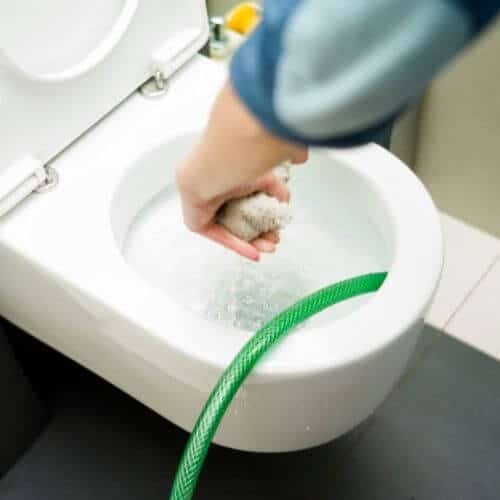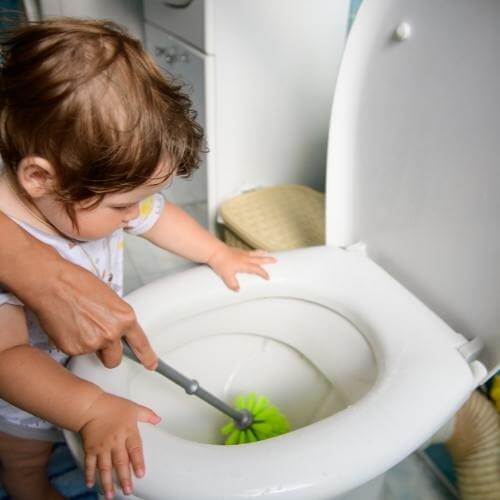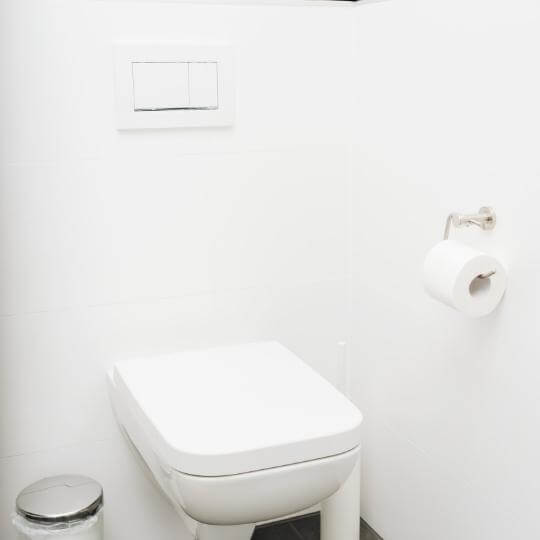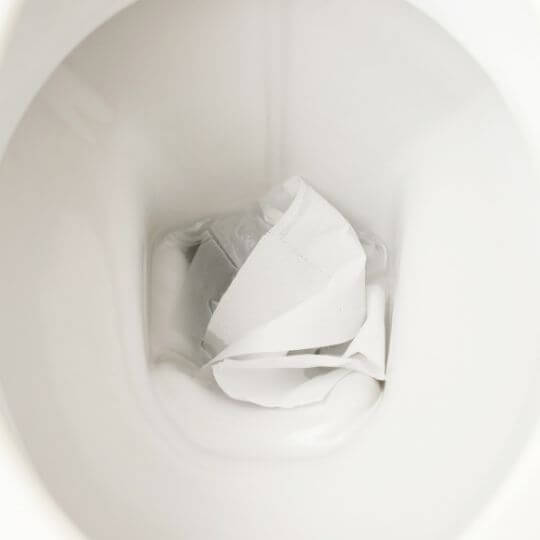What to do when toilet overflows in your bathroom, or even worse – at the guest house?
One of those nightmares everyone fears is having to deal with an overflowing toilet. An overflowing toilet typically points to a larger problem that should’ve been resolved a long time ago.
Why do toilets overflow? Is there a way to stop it and prevent it in the future? And – if it already happened – how can you repair the consequences? We explain it all to you in this article.
Why Is My Toilet Overflowing When I Flush?

An overflowing toilet may or may not be connected to the flushing itself.
It’s important to note the difference between the constantly running water in the toilet and the toilet overflowing from the bowl.
The cause also depends on the type of toilet you have, and even more – on the toilet tank itself.
Every toilet tank has a mechanism that allows for flushing. The most common ones are gravity-induced, but there are also upflush toilets that come with their own problems.
The toilet tank typically consists of a filler float, fill valve, chain, flapper, refill tube, and handle. [1]
It is precisely a toilet flapper or a toilet fill valve that may be at fault when you notice a toilet overflowing.
This is because a toilet flapper is what allows the water to exit the tank, but also stops it from exiting. This is why it’s also called a stopper; it’s also controlled by the push of a handle.
On the other hand, a toilet valve refills the tank with water every time the toilet flapper stops.
Keep in mind that a constantly running toilet can easily be fixed by adjusting the tank parts or changing the flush system.
However, if your toilet overflows from the bowl – then you may be dealing with the clog in the sewer system. A simple adjustment of the toilet tank parts won’t help here – you need to locate the clog.
What to Do When Toilet Overflows With Poop?

Dealing with toilet overflow with poop?
The first thing you need to do – as fast as possible – is to turn off the water supply!
To do so, find the main turn-off valve and turn it counter-clockwise completely until the water stops. The main shut-off valve is typically located behind a toilet or underneath the toilet tank.
Now that you stopped the water flow from coming into your toilet, you can proceed with unclogging the toilet.
Luckily for you, there are two immediate and simple ways in which you can resolve this situation. Let’s see what those are:
Unclogging a Toilet With a Brush

No matter where this happens, what you are most likely to have at hand is a toilet brush.
Yes, we’re speaking of those toilet brushes that stand next to a toilet and are used for removing poop stains.
This option is especially handy if you are dealing with poop stuck at the guest house. It can be embarrassing to ask for a plunger in this kind of situation.
Luckily, just a simple toilet brush is usually more than enough for unclogging some small clogs.
Simply try to push the stubborn waste down the toilet, but be careful while doing so too. You don’t want poop all over the place.
If this still doesn’t work, it’s possible some kind of vacuum got created down the waste line. It’s also possible that there was another clog in the pipes before you even used the toilet.
In that case, it’s best to opt for a plunger.
Unclogging a Toilet Using a Plunger

A toilet plunger is just what you need if there is a bigger clog or where the vacuum got created.
It will help create a powerful movement that will ensure the clog will be resolved with the least possible mess. [2] This is what a toilet plunger is made for, after all.
So, to start plunging, you need to make sure the plunger’s edges are moist. This will help create a better seal.
To do so, wet the plunger under a little bit of warm water or apply vaseline onto its edges.
Then, press the plunger inside a toilet bowl to create a vacuum. Start plunging gently at first, and then speed up as you feel the clog loosen.
You should be able to see the clog loosening up little by little.
After you’re done, flush a couple of times to make sure the clog is not there anymore.
What to do when toilet overflows, toilet brush or a plunger is nowhere near?

Luckily, there are even more ways to unclog a toilet.
But before we get into those, we need to advise you to prepare for this situation by wearing gloves. If the situation is that severe, you can even wear some protective clothes – better be safe than sorry!
Also, make sure to get some towels, wipes, or clothes in order to remove standing water. The water that spills out of the toilet can spread harmful bacteria, introduce mold, and cause health risks. [3]
You don’t want that water to sit on the bathroom floor either.
Let’s take a look at some of the other ways in which you can fix an overflowing toilet without a plunger:
- Drain Snake
A toilet draining snake is designed to break through those stubborn clogs that are not as accessible. You can use a drain snake even if the clog seems to be further down the waste line.
- Baking Soda & Vinegar
For smaller clogs, try pouring a cup of vinegar onto the clog. For larger ones, you can apply a solution of baking soda and vinegar and leave it overnight.
- Metal Cloth Hanger
It might sound gross at first (and it is) – but metal hangers actually do great with resolving clogs. It’s simple – adjust the wire of the hanger and push it into the clog to break it down.
- Dishwashing Detergent & Water
The keyword here is hot – you’ll need to pour boiling water onto the clog, as this breaks it down partially. Then, pour a dishwashing detergent over it.
How to Sanitize After Toilet Overflows?

It goes without saying, but wearing at least some protective gear will save you a lot of headaches.
If nothing else, please use gloves and make sure to wash your hands thoroughly after you finish the unclogging.
After a toilet overflows, you might feel as nothing will sanitize your toilet enough to make it sanitary again.
Disinfecting the bathroom is now crucial, as you don’t want to deal with bugs coming up the drain after that mess.
To sanitize the bathroom, create a cleaning solution by mixing one cup of bleach with one cup of water. Clean everything that came in contact with the waste, especially the floors, toilet, and walls.
However, keep in mind that bleach itself is not effective in unclogging the drains.
Be mindful of the possible irritations that bleach can cause – make sure to ventilate and wear gloves. [4]
Can a Toilet Overflow Without Being Clogged?

Not really. When a toilet overflows, it’s usually because there is a clog existing somewhere.
Just because you can’t see the clog, doesn’t mean that there isn’t one.
The possible clog might be further down the waste line – in the pipes or the septic tank. If unsure, make sure to read our article on toilet overflowing but not clogged.
It’s better to find and fix the clog than to deal with the consequences. Did you know that the water damage repair can cost anywhere from $2,500 to $7,500? [5]
The worst-case scenario usually happens when a clog meets a constantly running toilet. This is why it’s really important to fix this.
A constantly running toilet can also greatly increase your water bills. It wastes from 4,000 to 8,000 gallons per day, increasing the monthly cost up to 2-3 times. [6]
There is one exception to this rule – low-pressure toilets.
Some old toilets have low water pressure and aren’t strong enough to flush the waste properly. This can create a continuous problem because a clog creates easily.
That’s why, when you flush, a toilet might overflow in these situations.
So if you find that your toilet needs increased water pressure, make sure to at least replace the toilet tank.
The Takeaway
What to do when toilet overflows? The answer certainly isn’t to panic, despite the uncomfortable situation.
The first thing you need to do is to turn off the water supply. Then, do one of the things mentioned in this article to unclog the toilet.
It’s of crucial importance to stay safe and healthy, so finish off by sanitizing the bathroom.

Michael Davis is a heating & plumbing expert who currently works as independent contractor in SC. He also writes for Plumbertip.
For almost 10 years he worked on various plumbing tasks across South Carolina.


